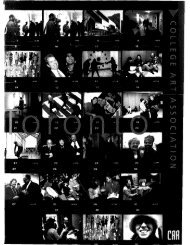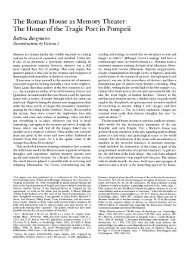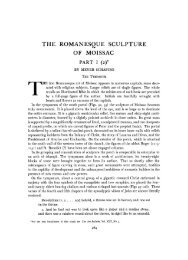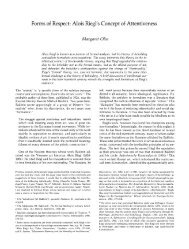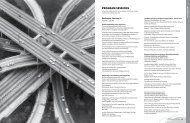THE HUMANISTIC THEORY OF PAINTING - College Art Association
THE HUMANISTIC THEORY OF PAINTING - College Art Association
THE HUMANISTIC THEORY OF PAINTING - College Art Association
You also want an ePaper? Increase the reach of your titles
YUMPU automatically turns print PDFs into web optimized ePapers that Google loves.
UT PICTURA POESIS: <strong>HUMANISTIC</strong> <strong>THE</strong>ORY <strong>OF</strong> <strong>PAINTING</strong> 199<br />
we may proceed to ask why the critics who named poets painters, also virtually identified<br />
the art of painting with the art of poetry.<br />
Chiefly responsible without question was the authority of two ancient treatises on<br />
literature: Aristotle's Poetics, and Horace's Ars poetica. Both Aristotle and Horace had<br />
suggested interesting analogies between poetry and painting, though they had by no means<br />
tended to identify them as did the Renaissance and Baroque critics. Aristotle had said for<br />
instance that human nature in action is the object of imitation among painters as well as<br />
poetsl2-an analogy that was as true of Italian painting of the Renaissance as it had been<br />
of ancient painting; and in arguing that plot was the most essential element in tragedy he<br />
had remarked that a canvas smeared at random with the loveliest colors will not give as<br />
much pleasure as a portrait done in outline.'3 Thus plot in tragedy in a general way re-<br />
sembles design in painting, and the comparison is, it appears, innocent enough. But<br />
comparisons which to Aristotle were certainly no more than a means of clarifying his<br />
discourse on the drama served the critics as a point of departure for developing their<br />
often questionable doctrine of the sister arts. The Ars poetica provided two particularly<br />
potent texts for this doctrine. One was a passage in which Horace after describing a paint-<br />
ing of grotesque hybrids and comparing it to a book whose vain imaginings are fashioned<br />
like a sick man's dreams, admits the equal right of painters and poets to liberty of imagina-<br />
tion, provided this potentially dangerous Pegasus be tethered to the stall of the probable<br />
and congruous.'4 The other was the famous passage containing the simile ut pictura poesis<br />
in which the poet, after remarking that the sensible critic will know how to excuse the faults<br />
that must occur even in great literature, pleads for further flexibility in critical judgment<br />
by declaring in effect that poetry should be compared to painting which exhibits not merely<br />
a detailed style that requires close scrutiny, but also a broad, impressionistic style that<br />
will not please unless viewed from a distance.'5 Again these comparisons were in their place<br />
12. Poetics ii. II: "'Erel b pJ oApOVWVt ot LLpoLKvotL rpdro7vraS<br />
"-"since artists imitate men doingor experiencing something."<br />
Aristotle goes on to say that both poets and painters<br />
imitate men as better or worse than ourselves or much as we<br />
are, Polygnotus depicting them as better, Pauson as worse,<br />
and Dionysius like ourselves (cf. xxv. 26-28). This fundamental<br />
passage, often quoted or remembered by Renaissance<br />
and Baroque critics (cf. notes 41 and 64), was brought<br />
very much up to date in the early eighteenth century by<br />
Antoine Coypel who applied it not only to French classic<br />
drama (Corneille had made men better than they are,<br />
Racine as they are) but to the Florentine, Venetian, and<br />
Flemish schools of painting: Michelangelo and Raphael<br />
painted men better than they are "par la grandeur de leur<br />
goft et l'l6vation de leurs idWes" (one detects here the<br />
growing Longinian influence), Titian as they are; but the<br />
Flemings and Dutch "les ont fait plus m6chants, c'est A<br />
dire par la bassesse des sujets et leur petit goit de dessin"<br />
(see Jouin, op. cit., p. 249). Cf. note 52.<br />
13. Op. cit. vI. 19-2I1:"'Apx)<br />
P ovv Kal o0ov I/v) 6 JIOs<br />
paypLcLaS, elrrepov 56 r&d J077. rapa7rXoLov y-p y rELv<br />
7r)s Kcal rl 7r '7s 7paCLK S. el aLs TLp vaXel4e 7 os aXXlfroTs c<br />
4apA&KoLI X6'7V, OhK a&V 6OoWS e<br />
6p&VELEV KiL AEUKoypaO0cLas<br />
eKcova."<br />
14. Ars poetica 1-13:<br />
"Humano capiti cervicem pictor equinam<br />
iungere si velit, et varias inducere plumas<br />
undique collatis membris, ut turpiter atrum<br />
desinat in piscem mulier formosa superne,<br />
spectatum admissi risum teneatis, amici?<br />
credite, Pisones, isti tabulae fore librum<br />
persimilem, cuius, velut aegri somnia, vanae<br />
fingentur species, ut nec pes nec caput uni<br />
reddatur formae. 'pictoribus atque poetis<br />
quidlibet audendi semper fuit aequa potestas.'<br />
scimus, et hanc veniam petimusque damusque vicissim;<br />
sed non ut placidis coeant immitia, non ut<br />
serpentes avibus geminentur, tigribus agni."<br />
As early as the thirteenth century Durandus with Horace<br />
in mind had already sanctioned the painter's freedom of<br />
imagination. Cennini in his Libro dell'arte (ed. Milanesi,<br />
Florence, 1859, p. 2) had compared poet and painter in a<br />
manner similar to Horace. Speaking of painting as coming<br />
next in honor after science, he remarks: "E con ragione<br />
merita metterla a sedere in secondo grado alla scienza, e<br />
coronarla di poesia. La ragione e questa: che il poeta, con<br />
la scienza prima che ha, il fa degno e libero di poter com-<br />
porre e legare insieme si e no come gli place, secondo sua<br />
volontA. Per lo simile al dipintore dato libertA potere<br />
comporre una figura ritta, a sedere, mezzo uomo, mezzo<br />
cavallo, si come gli piace, secondo sua fantasia." But with<br />
the grotesquerie of medieval art behind him, Cennini does<br />
not include Horace's deprecation of art that is "velut aegri<br />
somnia." For Durandus and Cennini see Borinski, op. cit.,<br />
I, 96-97. Cennini's coupling of painting with poetry on<br />
grounds of imaginative freedom is an interesting anticipa-<br />
tion of many passages in sixteenth- and seventeenth-century<br />
criticism. See notes 145, 171.<br />
I5. Ibid. 361-365:<br />
"Ut pictura poesis: erit quae, si propius stes,<br />
te capiat magis, et quaedam, si longius abstes.<br />
haec amat obscurum, volet haec sub luce videri,<br />
iudicis argutum quae non formidat acumen;<br />
haec placuit semel, haec deciens repetita placebit."



